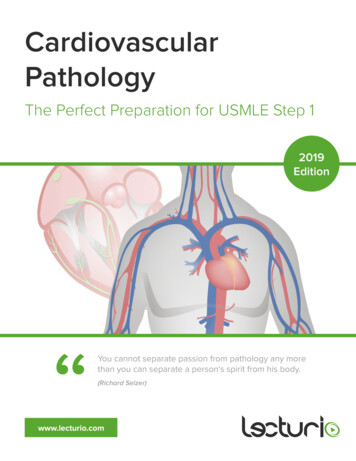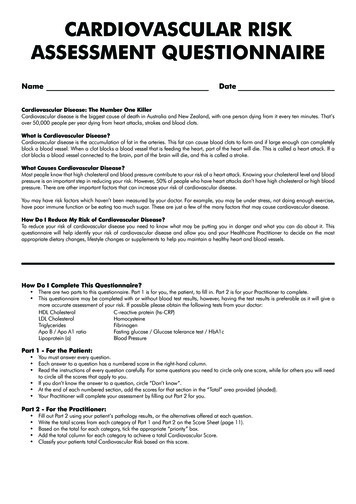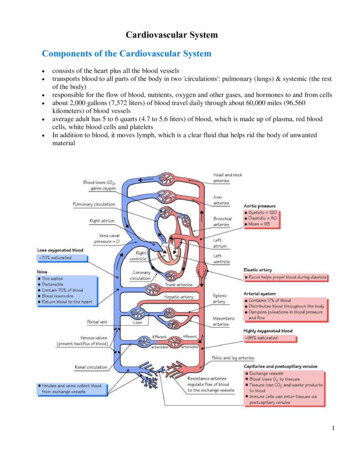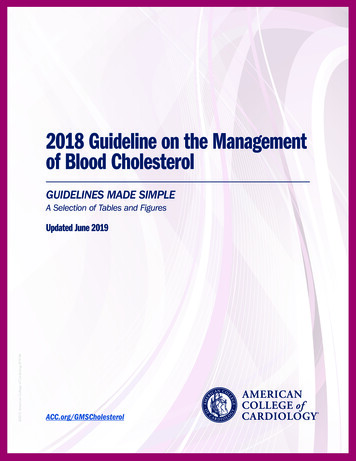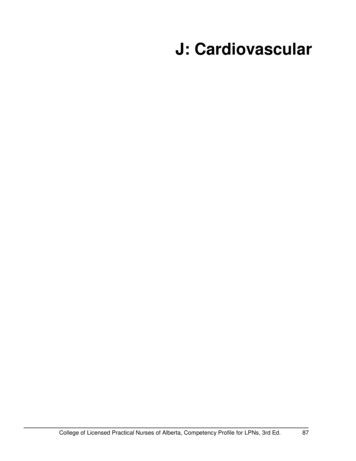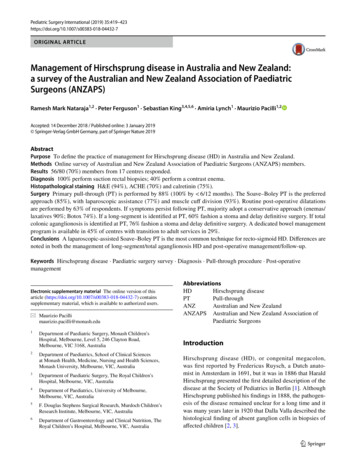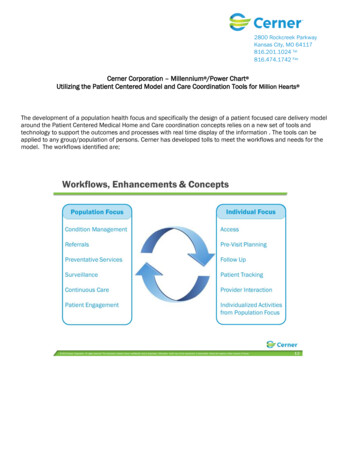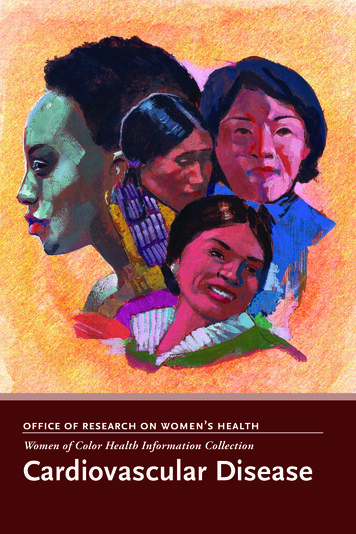
Transcription
office of research on women’s healthWomen ofHealth ��shealthCardiovascular Disease
Office of Research on Women’s HealthNational Institutes of HealthThe Office of Research on Women’s Health (ORWH), established in September 1990 withinthe Office of the Director, National Institutes of Health (NIH), works in partnership with theNIH Institutes and Centers (ICs) to ensure that women’s health research is part of the scientific framework at NIH and throughout the scientific community. ORWH collaborates withthe Advisory Committee on Research on Women’s Health (ACRWH), comprising physicians,scientists, and other health professionals; and the Coordinating Committee on Research onWomen’s Health (CCRWH), composed of the NIH IC Directors or their designees to implement the NIH strategic plan for women’s health and sex differences research.The ORWH mission is to: Advise the NIH Director and staff on matters relating to research on women’s health. Strengthen and enhance research related to diseases, disorders, and conditions thataffect women. Ensure that research conducted and supported by NIH adequately addresses issuesregarding women’s health. Ensure that women are appropriately represented in biomedical and biobehavioralresearch studies supported by NIH. Develop opportunities for, and support of, recruitment, retention, re-entry, andadvancement of, women in biomedical careers. Support research on women’s health issues.For more information on the ORWH mission, programs, and the NIH strategic plan forwomen’s health and sex differences research, Moving into the Future with New Dimensionsand Strategies for Women’s Health Research: A Vision for 2020 for Women’s Health Research,visit http://orwh.od.nih.gov.
Women of Color Health InformationCollection: Cardiovascular DiseaseINTRODUCTIONThe Women of Color Health Information Collection highlights the important role culture,race/ethnicity, socioeconomic background, geographic location, and other factors have onthe health status of women of diverse backgrounds. Data on the health status of women ofcolor are not readily available from a single source. Although clinical trials and populationbased surveys may include diverse populations, many do not report results disaggregated bysex and race/ethnicity or for minority subpopulations.This series of publications provides a variety of sources that highlight various diseases andconditions in women of color. Scientists, advocates, clinicians, and policymakers can use thisinformation to better understand the health status of women of color in the United States toformulate policies and researchpriorities, and to develop andThe ultimate goal of biomedical researchimplement clinical practicesis to increase knowledge gained throughthat promote the health ofsound science to inform the developmentall women.of policies and clinical practice standardsA challenge inherent to women’sfrom which all women and men can benefit.health research is to establish ascientific knowledge base thatwill permit reliable diagnoses and effective prevention and treatment strategies appropriatefor all women, including those of diverse racial/ethnic backgrounds. There is a need for betterunderstanding of how sex, gender, and cultural and racial/ethnic differences influence thepathobiology, etiology, diagnosis, progression, treatment, and outcomes of diseases amongdifferent populations.The expanded concepts of women’s health and women’s health research focus on the studyand understanding of women’s health as a reflection of the many elements that contribute tothe overall quality of women’s lives in the United States today. The ultimate goal of biomedical research is to increase knowledge gained through sound science to inform the developmentof policies and clinical practice standards from which all women and men can benefit.A Note about Terms Used in this BookletThis booklet uses terms established by the U. S. Census Bureau to describe race and ethnic categories of people.When presenting data gathered by independent researchers, this booklet retains their terminology.2 WOMEN OF COLOR HEALTH INFORMATION COLLECTION CARDIOVASCULAR DISEASE
Women’s health issues have gained increased attention since the Office of Research onWomen’s Health was established two decades ago. Federal offices, programs, legislation,and policies have been created to encourage study of women’s health issues and to promoteincluding women and minorities in clinical research. This progress reflects the recognitionthat for biomedical and behavioral research results to be widely applicable, researchers andclinicians must consider in their research design or healthcare delivery, how cultural, racial,sex/gender, and ethnic differences may influence the causes, diagnoses, prognosis, treatment,and outcomes of diseases among different populations.The NIH Revitalization Act of 1993, Public Law 103-43, requires that NIH-funded clinicalresearch include women and minorities, as scientifically appropriate. NIH recognizes that barriers exist to recruiting and retaining women of diverse backgrounds as research subjects. Thesebarriers include the effects of historical exclusion of women of child bearing age, mistreatmentof minorities in clinical research, and current impaired access to health care because of theeffects of poverty and inadequate health insurance. Cost, however, cannot be considered asa barrier, nor can it be used to justify excluding women and minorities from participating inclinical research, according to NIH policy based on the NIH Revitalization Act of 1993.These barriers can be overcome by increasing cultural diversity among researchers, promoting collaborative relationships between researchers and communities, overcoming logisticalissues related to women’s roles as caregivers and in the workplace, and appreciating culturalbeliefs of potential research participants.WOMEN OF COLOR IN THE U.S. POPULATIONOf the approximately 307 million estimated U.S. residents in 2009, about 51 percent werewomen according to the U.S. Census Bureau, as shown in Table 1. There is increasing racialand ethnic diversity in the United States and a growing population of non-White women. TheCensus Bureau estimated that in 2009, almost 11 percent of women were non-White, andHispanic* women constituted 7.61 percent of the total U.S. population.1*Hispanic origin is considered an ethnicity, not a race. Hispanics may be of any race.WOMEN OF COLOR HEALTH INFORMATION COLLECTION CARDIOVASCULAR DISEASE 3
Table 1: Estimated Total and Female Population of the United States by Race andHispanic Origin for 2009 Based on 2000 Census DataRace and Hispanic OriginTotal Maleand FemaleFemale % of TotalPopulationFemaleTotal U.S. Population (Hispanic and 1American Indian/Alaska Native (AI/AN)AsianNative Hawaiian/Pacific Islander ispanic 0.13%61,229Two or more races764,4640.79%381,828Non-Hispanic 0,958448,5100.09%223,052Two or more races4,559,0420.89%2,309,108Two or more races4,559,0420.89%2,309,108Two or more racesNH/PIAdapted from Annual Estimates of the Resident Population by Sex, Race, and Hispanic Origin for the United States: April1, 2000 to July 1, 2009 (NC-EST2009-03). 009-srh.html DateAccessed: September 10, 2010.4 WOMEN OF COLOR HEALTH INFORMATION COLLECTION CARDIOVASCULAR DISEASE
LEADING CAUSES OF DEATH IN FEMALESThe seven leading causes of death of women over age 18 in the United States are heart disease,cancer, stroke, chronic lower respiratory disease, Alzheimer’s disease, unintentional injuries,and diabetes mellitus. Based on 2007 data from the U.S. Centers for Disease Control andPrevention (CDC) shown in Table 2, heart disease and cancer are the first and second leadingcauses of death for African-American, White, and Hispanic women in the U.S. However, forAmerican-Indian/Alaska-Native and Asian- or Pacific-Islander women, cancer is the leadingcause of death and heart disease is the second leading cause of death. Stroke is the thirdleading cause of death for all women except for American-Indian/Alaska-Native women. 2Table 2: Leading Causes of Death in Females Age 18 and Older for the UnitedStates in 2007 by Percentage*AllAmerican Indian orAlaska NativeAsian or Pacific IslanderBlackWhiteHispanic**Heart 2.722.323.2Stroke6.85.09.57.06.75.7Chronic lower respiratory diseases5.55.02.52.76.22.9Alzheimer’s disease4.4N/A2.42.64.83.0Unintentional injuries3.48.23.62.73.44.3Diabetes mellitus3.06.74.25.12.55.8ConditionAdapted from U.S. Department of Health and Human Services, Health Resources and Services Administration, Maternaland Child Health Bureau. Women’s Health USA 2010. Rockville, Maryland: U.S. Department of Health and HumanServices, 2010. re.html. Date Accessed: September 19, 2011.*The data represent the percentage of total deaths in the race category due to the disease indicated.**The racial groups (White, Black, American Indian or Alaska Native, and Asian or Pacific Islander) include only persons ofnon-Hispanic origin. Persons of Hispanic origin may be of any race.Leading causes of death for each race/ethnicity appear in bold type.WOMEN OF COLOR HEALTH INFORMATION COLLECTION CARDIOVASCULAR DISEASE 5
BackgroundCardiovascular disease (CVD) is an abnormal functioning of the heart or blood vessels.3Heart disease (HD) is a general term for a variety of heart conditions.4 The most commonform of HD in women is coronary heart disease (CHD), also called coronary artery disease(CAD) because it involves the coronary arteries. Other types of CVD include hypertension,congestive heart failure, stroke, congenital cardiovascular defects, hardening or narrowing(atherosclerosis) of the blood vessels, including the coronary arties, and other diseases of thecirculatory system.5 Diabetes, hypertension, high cholesterol, obesity, lack of exercise, smoking, increased age, and family history are risk factors for cardiovascular (or heart) disease.In the United States, HD is theleading cause of death for Whites(men and women), Blacks (menand women), Hispanics (men andwomen), and American-Indian/Alaska-Native men. Cancer is the leading cause of death for American-Indian/Alaska-Nativemen and women and American-Indian/Native-American women.6Research also indicates that women areless likely than men to receive evidencebased cardiac care after a heart attack.In 2007, 421,918 women died from all forms of CVD. More female lives were claimed byCVD than were claimed by cancer, chronic lower respiratory disease, Alzheimer disease, andaccidents combined.5 In the same year, heart disease accounted for significant shares of alldeaths among women of each racial/ethnic subpopulation: White (25 percent), Black (25percent), Hispanic (22 percent), Asian/Pacific Islander (22 percent), and American Indian/Alaska Native (17 percent).66 WOMEN OF COLOR HEALTH INFORMATION COLLECTION CARDIOVASCULAR DISEASE
Many women are living with heart disease, but may not be aware of it: In 2008, about 5.8percent of all non-Hispanic White women, 7.6 percent of non-Hispanic Black women, and5.6 percent of Mexican-American women had coronary heart disease.5 Almost two-thirds ofthe women who die suddenly of coronary heart disease have had no previous symptoms.5More women than men die each year from CVD.7 However, in a 2009 survey, 30 percentof women underestimated their risk for heart disease, with racial and ethnic minority womenbeing more likely to underestimate their risk.8 Surprisingly, only 53 percent of women surveyedsaid that they would call 9-1-1 if they believed they were having a heart attack. Additionally,only 54 percent of women chose CVD as the leading cause of death among women, andwomen of color (Black, Hispanic, or Asian) were significantly less likely to identify CVD asthe leading cause of death.9 While women of all races and ethnicities are affected by CVD,a disparity exists between women of color and other women in their awareness andpersonalization of the risk for the disease.Furthermore, although 1 in 4 women in the United States dies from heart disease, a 2003study showed that women comprised only 27 percent of participants in all heart-relatedresearch studies,10 and a 2011 study found that in 325 landmark cardiovascular trials, theoverall rate of enrollment of women was 30 percent.11 Research also indicates that womenare less likely than men to receive evidence-based cardiac care after a heart attack.12WOMEN OF COLOR HEALTH INFORMATION COLLECTION CARDIOVASCULAR DISEASE 7
Susceptibility and ImpactMAJOR RISK FACTORS FOR CARDIOVASCULAR DISEASEHypertension: Hypertension is defined as an average systolic blood pressure greater thanor equal to140 mmHg or an average diastolic blood pressure of greater than or equal to 90mmHg. Hypertension is more common in African-American women than in White women,and has a much higher prevalence among Black women than other women of color.5 In 2008in the U.S., 46 percent of non-Hispanic black women age 20 and older had hypertension,compared to about 31 percent of non-Hispanic White and 29 percent of Mexican-Americanwomen.5 These rates of hypertension have been shown to vary with education level: theprevalence of hypertension among Black women with a high school education or higher is 37percent, compared to 51.2 percent of Black women with less than a high school education.Among Mexican-American and White women, 15.5 percent and 31 percent of women withhigher levels of education have hypertension, compared to 24.2 percent and 47.4 percent oftheir less educated counterparts, respectively.13 African-American women also are at greater riskfor severe complications from hypertension, such as stroke and heart failure.14Diabetes Mellitus: Diabetes mellitus (DM) is a group of diseases marked by high levels ofblood glucose resulting from inadequate insulin production or insulin action. DM can causeserious complications and premature death, and it is one of the leading causes of death anddisability in the United States, especially among women of color.9 As of 2011, an estimated25.8 million children and adults, or 8.3 percent of the population, suffer from DM. It hasmajor complicating effects on the cardiovascular system and frequently causes or exacerbatesconditions such as kidney and nervous system disease.15Elevated Total Cholesterol: High serum cholesterol is defined as 240 mg/dl and is oneof the major risk factors for CVD. It was found in roughly equal proportions among allsubpopulations of women age 20 and older in 2008. At that time, nearly one sixth of allnon-Hispanic White (16.9 percent) and non-Hispanic Black (13.3 percent) women hadhigh serum cholesterol, as did 14.0 percent of Mexican-American women.5 The percentageof women with high serum cholesterol has decreased for all three groups of women since2003-2004, and has decreased for men and women in each of these racial and ethnicgroups since 1988-94.58 WOMEN OF COLOR HEALTH INFORMATION COLLECTION CARDIOVASCULAR DISEASE
Tobacco Use: According to the American Heart Association, cigarette smoking is the “mostimportant preventable cause of premature death in the United States.”16 Smoking leads tothe accumulation of plaque in the arteries; this build-up blocks blood flow and can causecoronary heart disease and heart attacks.16 American Indians/Alaska Natives have an especiallyhigh prevalence of tobacco use: among American Indians/Alaska Natives age 18 and older in2007, 36.7 percent of men and 36 percent of women smoked, compared to only 23.1 percentof White men and 19.8 percent of White women who smoked.17Physical Inactivity: The American Heart Association recommends at least 150 minutes ofmoderate exercise per week (or 75 minutes per week of vigorous exercise) to promote cardiovascular fitness, since regular physical activity reduces the risk of dying from CVD.18 In a surveyconducted in the US from 2004-2008, 35.4 percent of White women, 54.2 percent of Blackwomen, 53.9 percent of Hispanic women, 41 percent of Asian women, and 43.1 percent ofAmerican Indian/Alaska Native women said that they were “inactive,” defined as no light,moderate, or vigorous leisure-time physical activity lasting at least 10 minutes.19Overweight or Obesity: The terms “overweight” and “obesity” refer to a person’s overallbody weight. The NIH defines “overweight” as having extra body weight from muscle, bone,fat, and/or water and “obesity” as having a high amount of extra body fat.20 Obesity can havesignificant effects on the body, especially the cardiovascular system; coronary heart disease,hypertension, and stroke are some of the major effects of obesity.21 As of 2009, 23.3 percent ofWhite women, 41.9 percent of African-American women, and 30.8 percent Hispanic-Americanwomen were categorized as obese.22 One widely used measure of whether an individual isoverweight or obese is body mass index (BMI). BMI is based on height and weight and can beused for men and women of all ages. Instructions on calculating BMI can be found at the website for the National Heart, Lung, and Blood Institute: http://www.nhlbisupport.com/bmi/.INCIDENCE AND DEATH RATES FROM CARDIOVASCULAR DISEASEHeart Disease in Asians and Native Hawaiians/Pacific Islanders: Asian-Americanadults have the lowest prevalence of heart disease, hypertension, or stroke of any majorracial or ethnic group (among White, Black, Native Hawaiian/Pacific Islander, or Hispanicadults). These statistics are likely partly due to decreased behavioral risk factors for CVD inWOMEN OF COLOR HEALTH INFORMATION COLLECTION CARDIOVASCULAR DISEASE 9
the population: Asian-American adults are the least likely among the racial and ethnic groupsto be current smokers or to be overweight or obese, and they are the most likely to get someleisure-time physical activity. However, when the population of “Asian” is disaggregatedand different subgroups are analyzed independently, Native Hawaiians/Pacific Islanders areactually more likely than Whites to be obese or to classify themselves as inactive; more than45 percent of Native Hawaiians/Pacific Islanders say they are inactive (defined as no light,moderate, or vigorous leisure-time activity lasting at least 10 minutes).23 In 2007, the heartdisease death rate was 82 per 100,000 Asian- and Pacific-Islander women, or approximately halfthe death rate from heart disease of non-Hispanic White women (Table 3).24Table 3: Age-Adjusted Heart Disease Death Rates in 2007MenWomenRace and Hispanic* OriginRate per 100,000Ratio to NonHispanic WhiteRate per 100,000Ratio to NonHispanic WhiteNon-Hispanic White239.81.00153.01.00Asian/Pacific Islander126.00.5382.00.54Black/African American305.91.28204.51.34American Indian/Alaska Native159.80.6799.80.66Hispanic or Latino(a)165.00.69111.80.73Source: Table 3. Health, United States, 2010: With Special Feature on Death and Dying. Hyattsville, MD. 2011.*The race groups Black, Asian or Pacific Islander, and American Indian or Alaska Native include persons of Hispanic andnon-Hispanic origin. Persons of Hispanic origin may be of any race. Death rates for the American Indian or Alaska Nativeand Asian or Pacific Islander populations are known to be underestimated.Heart Disease and African Americans: African-American adults have the highestprevalence of coronary heart disease, hypertension, and stroke of all racial and ethnic groupsstudied (among White, Black, Native Hawaiian/Pacific Islander, or Hispanic adults). Amongwomen, African-American women are more likely to suffer from each of these conditionsthan their non-Hispanic White and Hispanic counterparts.23 African-American women alsohad the highest age-adjusted death rate from heart disease in 2007 (204.5 per 100,000), morethan 1.3 times that of non-Hispanic White women (100 per 100,000, Table 3).24 In 2009,nearly 11 percent of African-American women suffered from heart disease, while over 35percent had high blood pressure.2310 WOMEN OF COLOR HEALTH INFORMATION COLLECTION CARDIOVASCULAR DISEASE
Heart Disease and American Indians/Alaska Natives: American-Indian/Alaska-Nativeadults are more likely to be obese than White adults; they are also more likely than whiteadults to describe themselves as “inactive,” or having no light, moderate, or vigorous leisuretime activity for at least 10 minutes. Among American Indians or Alaska Natives age 18 andolder, 8 percent have heart disease, 4.1 percent have coronary heart disease, and 21.8 percenthave hypertension.23 In 2007, the death rate for heart disease was 99.8 per 100,000 AmericanIndian or Alaska-Native females (Table 3).23Heart Disease and Hispanics: Hispanic-American women are slightly less likely to haveany form of heart disease than non-Hispanic women,23 and Hispanic women are less likely todie from heart disease than White women.9 Hispanic women are also less likely to be currentsmokers, but they are more likely than non-Hispanic White women to be obese and to bephysically inactive in their leisure time. In 2009, 8.4 percent of Hispanic women had heartdisease and 22.5 percent had hypertension.23 In 2007, the death rate for heart disease was111.8 per 100,000 Hispanic women (Table 3).24WOMEN OF COLOR HEALTH INFORMATION COLLECTION CARDIOVASCULAR DISEASE 11
Research HighlightsAmerican Heart Association Survey of Awareness, Knowledge, and Perceptions Relatedto Heart Disease and Stroke: U.S. Minority Women Know Less about Heart DiseaseThough women of color are at greater risk for CVD, they know less about risks and signs ofthe disease than White women, according to an American Heart Association (AHA) survey.Significantly more women surveyed in 2009 were aware that heart disease is the top killer ofwomen than were aware in 1997 (54 percent in 2009 versus 30 percent in 1997). Awarenessthat heart disease is the leading cause of death for women approximately doubled amongHispanic women and nearly tripled among Black women surveyed between 1997 and 2009.However, the disparity in awareness of heart disease’s mortality ranking among Black andHispanic women (43 percent and 44 percent, respectively) compared to white women (60percent) had not significantly improved since 1997. Even though more women surveyed in2009 considered themselves well-informed about heart disease compared to women surveyedin 1997 (45 percent vs. 34 percent), knowledge of heart attack warning signs did not differappreciably between the surveys.12Though women of color are at greaterThe study authors suggest that,“one potential way to eliminaterisk for CVD, they know less about risksor reduce health disparities in theand signs of the disease than WhiteUnited States is through morewomen, according to an Americantargeted efforts to raise awarenessamong racial and ethnic minoriHeart Association surveyties who are least aware of heartdisease and stroke, and also atgreatest risk.”25Hot Flashes and Subclinical Cardiovascular Disease: Findings from the Study ofWomen’s Health Across the Nation Heart StudyStudies suggest that hot flashes may be related to changes in the vasculature in the perimenopausal period, but it is not known if hot flashes are associated with CVD. This study, initiatedin 1996, examined the relation between menopausal hot flashes and several measures of subclinical CVD, with the hypothesis that women who experienced hot flashes would be morelikely to have certain indices of subclinical CVD. The study analyzed data from the Studyof Women’s Health Across the Nation (SWAN) Heart Study and included 492 women (3512 WOMEN OF COLOR HEALTH INFORMATION COLLECTION CARDIOVASCULAR DISEASE
percent African American, 65 percent White), ages 45-58, who were free of clinical CVD.Measurements in this study included a brachial artery ultrasound to assess flow mediateddilation, electron beam tomography to assess coronary artery and aortic calcification, reportedhot flashes (any/none, previous two weeks), and a blood sample for measurement of estradiolconcentrations. Hot flashes were associated with significantly lower flow mediated dilation.The researchers found that women with hot flashes had arteries that did not dilate as wellwith increased blood flow, as well as increased calcification of the aorta. Study authors suggested that hot flashes may mark adverse underlying vascular changes among midlife women,meaning that this menopausal symptom could have clear clinical significance, in addition toits impact on quality of life.26The Women’s Ischemia Syndrome EvaluationThis multicenter study initiated in 1996 greatly increased understanding about CHD inwomen and about gender-specific symptoms, risk factors, and pathology. The study enrolledand studied over 900 women who had symptoms of CHD (chest pain, shortness of breath)and were referred for diagnostic angiography. It found that women are more likely to haveplaque build-up that spreads evenly along artery walls rather than forming large blockages.Even though women with this condition may have angina similar to people with large blockages and often go on to have heart attacks, they may be categorized as low risk for heart eventsbecause their arteries look clear. These findings indicate that CHD risk factors should beaddressed aggressively in women with symptoms, even in the absence of a positive imagingfor arterial blockages, and that better approaches to evaluate cardiac ischemia in women shouldbe developed and used.27Women’s Health Study of Low-Dose Aspirin in Apparently Healthy WomenThis study, initiated in 1993, found that low-dose aspirin and vitamin E supplements playa minor role, if any, in protecting women from CVD. Contrary to results seen in men,aspirin use in women 45 and older did not prevent first heart attacks or CVD deaths. It did,however, reduce strokes by 17 percent in the overall study cohort and lower the risk of majorCVD events by 26 percent among women who were 65 years of age or older.28 The studyalso showed that vitamin E supplementation had no effect on heart attacks, strokes, or totaldeaths and, with regard to another hypothesized benefit, did not reduce rates of breast, lung,WOMEN OF COLOR HEALTH INFORMATION COLLECTION CARDIOVASCULAR DISEASE 13
colon, or other cancers.29 Rather than an aspirin or vitamin E regimen, the NIH continues torecommend that women focus on other well-proven approaches for reducing their risk ofheart disease and stroke: eating healthfully, getting regular physical activity, maintaininga healthy weight, abstaining from smoking, and controlling high cholesterol, high bloodpressure, and diabetes.The Growth and Health StudyResults from the NHLBI Growth and Health Study, an observational study that followedcohorts of White and African-American girls from childhood to early adulthood, highlightthe importance of teaching girls as young as age 9 about behaviors to maintain a healthyweight. Rates of being overweight increased from age 9 to 18 from 7 percent to 10 percentamong White girls, and from 17 percent to 23 percent among African-American girls, withthe greatest jump in weight gain occurring between ages 9 and 12 years. Girls who wereoverweight during childhood were 11 to 30 times more likely to be obese in young adulthood. Moreover, being overweight was significantly associated with high blood pressure andhigh cholesterol during adolescence. The findings underscore that efforts to reduce CVD riskin women should begin early in life.3014 WOMEN OF COLOR HEALTH INFORMATION COLLECTION CARDIOVASCULAR DISEASE
Cardiovascular DiseasePrevention ProgramsU.S. Centers for Disease Control and PreventionHeart Disease and Stroke Prevention Program: In 1998, Congress providedfunding to the U.S. Centers for Disease Control and Prevention (CDC) to create anational state-based heart disease and stroke prevention program. The goals of thisprogram are to increase state capacity by planning, implementing, tracking, and sustaining population-based interventions that address heart diseases, stroke, and related riskfactors (high blood pressure, high blood cholesterol, tobacco use, physical inactivity, andpoor nutrition). The population-based strategies in this program focus on an identifiedpopulation (women aged 35-65 years) or area (residents of state) rather than individualbehavior change. Health departments in 41 states and the District of Columbia currentlyreceive funding. The program stresses policy and education to promote heart-healthyand stroke-free living and working conditions.31 http://www.cdc.gov/dhdsp/programs/nhdsp program.Well-Integrated Screening and Evaluation for Women Across the Nation (WISEWOMAN) Program: WISEWOMAN provides low-income, under-insured, 40- to64-year-old women with the knowledge, skills, and opportunities to improve their diet,physical activity, and other lifestyle behaviors to prevent, delay. and control cardiovascular and other chronic diseases. WISEWOMAN also provides cholesterol tests and otherchronic disease risk factor screening. CDC funds 21 WISEWOMAN projects in 19states and two tribal organizations.32 http://www.cdc.gov/wisewoman/.Women and Heart Disease: An Atlas of Racial and Ethnic Disparities in Mortality:This publication presents national and state maps depicting disparities in county-level heartdisease death rates among the five largest U.S. racial and ethnic groups. This in
The expanded concepts of women’s health and women’s health research focus on the study and understanding of women’s health as a reflection of the many elements that contribute to the overall quality of women’s lives
